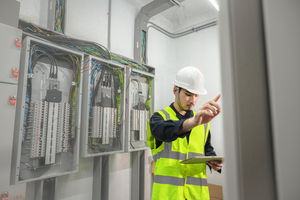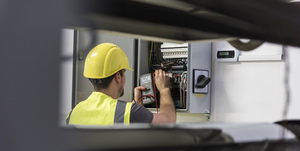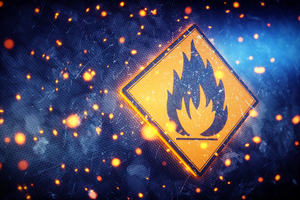
 |
Charlotte Stonestreet
Managing Editor |
| Home> | MACHINE BUILDING & ENGINEERING | >Machinery Safety | >Ensuring electrical safety in hazardous areas |
Ensuring electrical safety in hazardous areas
05 July 2023
CONDUCTING DETAILED inspections of EX equipment prior to first use can help identify potential installation quality issues, as well as ensuring the equipment is suitable for use, as Ian Wright outlines

INCREASINGLY, MACHINERY and other equipment is being used in potentially hazardous environments to automate or control certain production processes. This poses an increased risk of fire and explosion, so equipment must meet the enhanced requirements of applicable regulations and standards. However, the normal operation of equipment often involves actions or reactions which represent a potential ignition source, such as:
- Electric sparks – A poor quality component or electrical connection can fail, inadvertently producing an electric spark that can ignite explosive atmospheres.
- High operating temperature – Depending upon the potentially explosive atmosphere present, hot surfaces of equipment could cause an auto-ignition. Process system heating effects by ‘work done’ i.e. pumping systems, must also be considered as these can elevate the ‘product’ above its flashpoint.
- Electrostatic discharge – Some normal equipment operations can generate static electricity, which can serve as an ignition source at certain levels.
- Friction sparks – Equipment operation may also involve repeated contact between materials, resulting in friction that can produce heated sparks and material contents must be considered as a potential ignition source.
Ex-rated equipment has therefore been classified as safe for use in hazardous areas as it is designed to contain or prevent any sparks, flames, or explosions. However, poor installation of EX equipment can compromise its integrity. Conducting initial detailed inspections prior to first use will therefore help to identify potential installation quality issues, as well as ensuring the equipment is suitable for use.
Tackling hazardous environments
In the UK, the UKCA Ex Regulation provides a detailed overview of the essential health and safety requirements applicable to equipment used in hazardous environments. However, the specific technical requirements to demonstrate compliance for various types of equipment and operating environments are found in nearly 100 individual harmonised standards. Depending on the equipment and its intended use, this means that more than one harmonised standard may be applicable to the evaluation and certification process.
Under the provisions of the UKCA Ex Regulation, evidence of compliance is generally demonstrated by the issuance of a manufacturer’s or supplier’s Declaration of Conformity. The task of demonstrating compliance rests with the party responsible for introducing a product into the marketplace or putting into first use (i.e. not put onto the market but made in-house).
In the European Union there are two ATEX Directives – one for the manufacturer and one for the user of the equipment. The ATEX 114 "equipment" Directive 2014/34/EU focuses on the responsibilities of manufacturers of Ex-rated machinery and other equipment. In the UK, it is implemented by The Equipment and Protective Systems Intended for Use in Potentially Explosive Atmospheres Regulations 2016, which is law.
The legislation’s function is to ensure that the design and manufacture of equipment intended for explosive atmospheres conforms with the Essential Health and Safety Requirements, so that these are met before anything is placed on the market. This is typically achieved by third-party testing and certification by an Approved or Notified Body. However, after machinery has been installed, how can you verify that conformity and compliance have been achieved?
To ensure the installation quality and integrity of Ex-rated equipment post installation an intrusive inspection by a competent person should be carried out. This is described within the requirements of EN 60079-17 as an ‘Initial Detailed Inspection’. If carried out correctly, such an inspection will ensure that the equipment, including its internal and external components, are fit for purpose and installed correctly.
External to Europe and the UK, the IECEx conformity mark is evidence that a manufacturer’s products have been independently assessed against the additional requirements of the IECEx conformity mark licensing system. The mark license number is issued to a manufacturer by an accepted IECEx certification body (ExCB) that has entered into a mark license agreement with the IEC.
Ensuring machinery safety
Manufacturers spend thousands of pounds designing and testing equipment intended for explosive areas, and typically the end-user will pay a premium for these products. So, if your installer compromises the manufacturer’s design, this invalidates the equipment and creates a potentially dangerous installation. As an example, they might discard cable gland internals and decide that the simplest way to hang an Ex-rated light fitting is to drill through the casing to mount it, or they might drill and tap the lid of an Ex-rated enclosure to fit an identification label.
Also, assuming the issue is identified, there will be a significant financial cost to re-establish compliance. This is so often the case when an end-user takes delivery of, for example, a packaged skid assembly which has been manufactured off-site at a supplier’s premises. In such circumstances, Ex-related issues are only found during the completions, inspections and commissioning process. The consequence will be delays to commissioning and potentially start-up, alongside unplanned additional financial costs.
Installer competency is often a key issue, as it is common for suppliers and installers to hire workers for ad-hoc projects. While keeping a core team of trades people as full-time employees is not always financially viable, it does make the assurance of installer competency a difficult area to manage.
However, the problem can be more systemic, and looking at the bigger picture the questions might be - did the supplier fully understand what they were asked to build and to what standard? Were the specifications and design documents supplied by the end-user or designer adequate? Did they cover the required legislative areas correctly and suitably? Were the appropriate standards referenced? At this point in a project disputes and frustrations are common, which can lead to further delays and cost – all of which can be avoided.
Employing competent, impartial and independent Ex inspectors to inspect installations and carry out detail inspections prior to initial use, or in the case of the suppliers, prior to shipping, is a key element to detecting and rectifying problems early. Engaging a competent inspector to monitor the build, offer advice and potentially mentor as the installation progresses is an area that is often overlooked. However, by doing so there is significant potential to minimise or eliminate the need for rework after inspection.
Another area that is commonly discounted is the use of an independent and impartial specialist to review the technical documentation and project deliverables with respect to the installation of Ex electrical and non-electrical equipment. Design reviews, alongside build monitoring and inspection during the whole lifecycle of the project, will ensure both compliance and quality are achieved first time and on time. It is clear that ensuring that the supplier or installer knows exactly what they are tasked with delivering is key to ensuring the safe and successful delivery of new Ex installations. Specifying the scope and required level of competency is therefore vital, alongside the involvement of competent people in the design, procurement and installation in order to help to mitigate Ex compliance issues.
Electrical equipment used in hazardous environments must be expressly designed to minimise risks, and manufacturers of such equipment and systems must ensure that their products meet the requirements of applicable regulations and standards. To be able to eliminate the potential ignition sources, which can include considered faults, prior to manufacture and installation, a pre-assessment is recommended to understand the equipment design, operation and desired location and environment.
Ian Wright is chief engineer at TÜV SÜD
Key Points
For use in hazardous areas, Ex-rated equipment is designed to contain or prevent any sparks, flames, or explosions
To ensure installation quality and integrity of Ex-rated equipment, an inspection by a competent person should be carried out
Design reviews, build monitoring and inspection during the whole lifecycle of the project, help ensure compliance and quality
- Machinery Safety UCPD Courses
- TÜV SÜD UK Appoints Mary Grigsby as Head of Product Service
- TÜV SÜD launches academy to optimise UK industry compliance
- Electrical safety training
- Machinery safety risk assessment
- Getting the PUWER factor right
- TÜV SÜD BABT appointed as Machinery Notified Body
- New UK divisional director
- New machinery guarding standard
- Machinery & UKCA marking





















